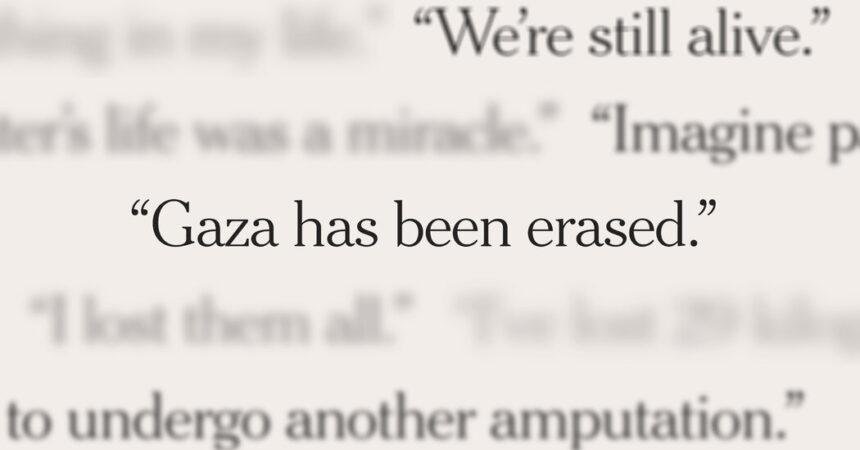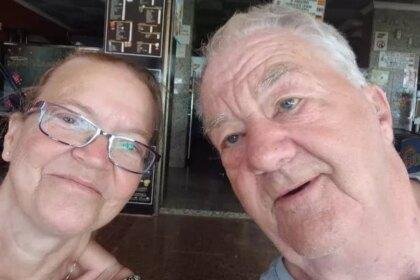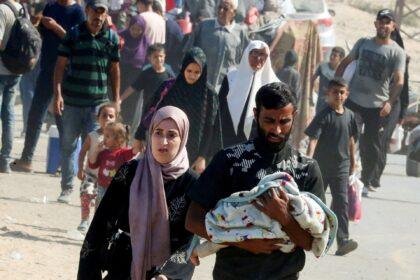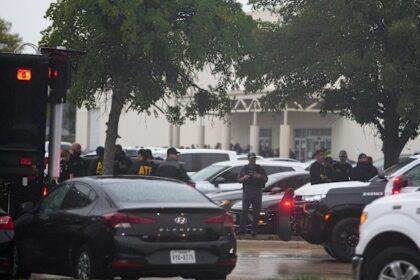The Unfolding Tragedy of Gaza: Voices from the Ruins
A Humanitarian Crisis in the Heart of Conflict
In the past two years, the ongoing conflict in Gaza has left an indelible mark on its inhabitants, with countless stories of loss, despair, and resilience emerging from the rubble. As reported by various news outlets, including The New York Times, the situation has escalated to a point where the very fabric of society is fraying. The humanitarian crisis has reached alarming levels, with families torn apart, homes destroyed, and basic necessities becoming increasingly scarce.
- A Humanitarian Crisis in the Heart of Conflict
- The Weight of Grief
- The Struggle for Survival
- Displacement and Loss
- The Impact of Military Operations
- A Glimmer of Hope Amidst Despair
- Conclusion: The Need for Global Attention
- A Cycle of Displacement and Loss
- The Struggle for Survival
- The Weight of Fear and Despair
- The Harsh Reality of Displacement
- The Quest for Normalcy
- Conclusion: A Call for Awareness and Action
- A Landscape of Loss
- The Weight of Dreams
- A Sense of Hopelessness
- Aspirations Amidst Adversity
- The Quest for a Normal Life
- The International Response
- Conclusion
The Weight of Grief
The emotional toll of the conflict is palpable. Many individuals have lost not just their homes but also loved ones. Ismail al-Sheikh, who spoke to reporters in January 2025, shared the harrowing reality of losing nearly 40 relatives. “That alone feels like more than enough grief for one lifetime,” he lamented. Such sentiments echo throughout Gaza, where grief is a shared experience, binding the community in sorrow.
Hanaa al-Najjar, another resident, expressed the overwhelming nature of their suffering: “Our lives are nothing but suffering on top of suffering.” This collective grief is compounded by the constant threat of airstrikes, which has forced families to flee multiple times, often with little more than the clothes on their backs.
The Struggle for Survival
The daily struggle for survival in Gaza is exacerbated by the dire economic conditions. Many families are grappling with malnutrition, as food supplies dwindle and prices soar. Reports indicate that some individuals have lost significant weight, with mothers like Yasmin al-Attar focusing solely on securing one meal for their children. “As a mother, all I think about is how to save one meal for tomorrow,” she said, highlighting the desperate choices families are forced to make.
The situation is further complicated by the lack of access to medical care. Many residents are in urgent need of treatment but are unable to secure evacuation due to the ongoing conflict. The hope for a return to normalcy seems increasingly distant, as families are left to navigate a landscape of destruction and despair.
Displacement and Loss
Displacement has become a grim reality for many in Gaza. The conflict has forced families to relocate multiple times, often to makeshift shelters or charity camps. For instance, Samar al-Jaja and her nephews, who lost their parents in an airstrike, found themselves living in a charity camp, holding onto the hope of returning home. However, when they finally did return, they were met with the stark reality that only their parents’ bedroom remained standing.
The emotional scars of such experiences are profound. “Even that closure has been taken from us,” al-Jaja lamented, reflecting on the inability to mourn properly for her lost family members. The traditional customs surrounding death, such as distributing sweets or holding prayers, have become luxuries that many cannot afford.
The Impact of Military Operations
The military operations in Gaza have intensified, with Israeli forces conducting raids and airstrikes in response to ongoing hostilities. The conflict, which escalated dramatically after the October 7, 2023, attack by Hamas, has led to a cycle of violence that seems unending. Negotiations for a potential ceasefire or prisoner exchange have been ongoing, but the situation remains precarious.
As families await news of their loved ones, the psychological toll of uncertainty weighs heavily. Many have lost contact with relatives, and some have received the devastating news of their deaths. The emotional landscape of Gaza is one of fear, anxiety, and a longing for peace.
A Glimmer of Hope Amidst Despair
Despite the overwhelming challenges, there are moments of resilience and hope. Families like that of Hammam Malaka, who were separated for much of the conflict, managed to reunite during a brief ceasefire. However, their joy was overshadowed by the loss of their three-year-old daughter, Seela, who was killed while they were apart. “I ran and hugged her and our children with everything in me,” Malaka recounted, a bittersweet reminder of the fragility of life in Gaza.
The struggle for survival continues, with families like the Malakas facing the harsh realities of hunger and danger. Many have resorted to desperate measures, such as scavenging for food or lining up for aid, as the humanitarian situation deteriorates further.
Conclusion: The Need for Global Attention
The stories emerging from Gaza are not just statistics; they are the voices of individuals and families grappling with unimaginable loss and hardship. As the conflict rages on, the international community must pay attention to the humanitarian crisis unfolding in this region. The resilience of the people of Gaza is commendable, but without urgent intervention and support, the cycle of suffering is likely to continue.
In the face of adversity, the people of Gaza remain hopeful for a brighter future, one where they can rebuild their lives and communities. However, that hope hinges on the global community’s willingness to act and bring about lasting peace. The time for action is now, as the stories of grief and resilience continue to unfold in the heart of Gaza.
Life Amidst Ruins: The Struggles of Gazans in a War-Torn Landscape
As the conflict in Gaza continues to unfold, the daily lives of its residents have become a harrowing testament to resilience in the face of overwhelming adversity. Amidst the chaos, stories of survival emerge, revealing the profound emotional and physical toll of living in a war zone. This article delves into the experiences of individuals who have endured unimaginable hardships, highlighting their struggles, hopes, and the stark reality of life in Gaza.
A Cycle of Displacement and Loss
In January, during a brief ceasefire, one resident returned to Gaza City, hoping for a semblance of normalcy. However, that hope quickly dissipated. “That was the last good thing that happened,” he recounted, reflecting on the tragic losses that followed. In June, he lost his wife’s sister to an airstrike, and by September, his uncle had also fallen victim to the violence. Since the beginning of the year, he has been displaced four times, a grim reminder of the instability that has plagued the region for decades.
The ongoing conflict has not only uprooted families but has also inflicted physical injuries. This individual was wounded twice in airstrikes, once while at home and again while passing a bombed high-rise. “The hardest thing is living with the feeling that all you can do is wait for death,” he lamented, expressing the despair that has become a constant companion for many in Gaza.
The Struggle for Survival
The economic ramifications of the conflict have been devastating. Once a vendor selling shawarma, this father now spends his days scavenging for food, clean water, and cash to afford skyrocketing market prices. “Daily life is another kind of war,” he stated, emphasizing the relentless struggle to provide for his children. Many days, the only meal he could offer was bread with cheese and thyme, a stark contrast to the vibrant culinary culture that once thrived in Gaza.
The anguish of merely surviving permeates the lives of countless Gazans. Fatma Edaama, another resident, poignantly remarked, “Even animals, if they were subjected to what we’ve lived through, couldn’t become accustomed to it. We are living through a catastrophe.” Her words encapsulate the collective trauma experienced by a population that has endured years of conflict, blockades, and humanitarian crises.
The Weight of Fear and Despair
As families navigate the treacherous landscape of war, the psychological toll is equally devastating. Amir Ahmed, a father, shared his struggle to maintain hope for his children amidst the chaos. “I try to hold on to hope – to be the father who reassures his children,” he said, yet he admitted that fear and despair haunt them daily. The sound of bombings and warplanes has left children like Safaa Zyadah’s daughter, Batoul, waking up screaming in terror, a stark reminder of the psychological scars inflicted by the conflict.
The uncertainty of tomorrow looms large for many. Mohammed Shubeir, another resident, expressed the anguish of sleepless nights filled with dread. “Every night, I lie awake wondering if tomorrow will bring anything better, or if it’ll just add another layer of pain,” he said, reflecting the pervasive sense of hopelessness that has gripped the region.
The Harsh Reality of Displacement
The plight of those who have managed to leave Gaza is fraught with its own challenges. Niveen Foad, who evacuated to Italy with her children, grapples with feelings of guilt for leaving loved ones behind. “I feel like I betrayed my own country by leaving,” she confessed, yet she also recognizes the necessity of seeking a better life for her children. “Sometimes I think that I deserve a chance in life,” she added, highlighting the complex emotions faced by those who escape the violence but remain tethered to their homeland.
For many, the safety of foreign lands is overshadowed by the anguish of separation. Niveen’s thoughts often drift back to her father in Gaza, who remains in danger. “My tears poured down, thinking I can afford to buy food and eat, but they can barely get anything,” she lamented, illustrating the stark contrast between her new life and the struggles of those still trapped in the conflict.
The Quest for Normalcy
Despite the overwhelming challenges, some individuals strive to rebuild their lives. Niveen is learning Italian and training to be an assistant chef, a step toward a new beginning. Yet, the memories of Gaza linger, and she believes that her future is still tied to her homeland. “Whatever happens, I’ll end up in Gaza,” she stated, underscoring the deep-rooted connection many feel to their land, despite the ongoing violence.
Maher Ghanem, a former security officer, reflects on the absurdity of his current reality. After losing his wife to cancer due to restricted access to medical care, he has remarried to care for his seven children. “There isn’t a glimmer of hope left in Gaza,” he said, echoing the sentiments of many who yearn for a way out of the cycle of violence and despair.
Conclusion: A Call for Awareness and Action
The stories emerging from Gaza serve as a poignant reminder of the human cost of conflict. As the world watches, it is crucial to recognize the resilience of those living amidst ruins and the urgent need for humanitarian assistance. The plight of Gazans is not just a distant tragedy; it is a call to action for the global community to advocate for peace, support humanitarian efforts, and work towards a future where families can live without fear and with the hope of rebuilding their lives. The resilience of the human spirit shines through even in the darkest of times, but it is imperative that this spirit is met with compassion and support from the world beyond Gaza’s borders.
The Uncertain Future of Gaza: Voices from the Ground
As the conflict in Gaza continues to unfold, the voices of its residents reveal a profound sense of despair and uncertainty about the future. Amidst the rubble and chaos, individuals express their hopes, dreams, and fears, painting a stark picture of life in a region long plagued by violence.
A Landscape of Loss
In the heart of Gaza, Mohammed El-Sabti, a local shopkeeper, encapsulates the sentiment of many when he states, “The future has gone, the shop has gone, my sons’ and daughters’ future has gone, the feeling of happiness has gone.” His words resonate deeply, reflecting not just personal loss but a collective mourning for a way of life that has been irrevocably altered. The ongoing conflict has left many residents feeling as though their aspirations have been extinguished, with little hope for recovery.
Historically, Gaza has been a focal point of Israeli-Palestinian tensions, with its residents enduring cycles of violence that have disrupted daily life for decades. The current situation, marked by intensified military actions and humanitarian crises, has exacerbated these longstanding issues, leaving many to question whether a semblance of normalcy can ever return.
The Weight of Dreams
For the youth of Gaza, the conflict has not only robbed them of their present but has also cast a shadow over their future. Shahd Jweifel, a high school student, dreams of the war ending so she can finally sit for her exams-an opportunity she has been preparing for over two years. Her aspirations highlight the plight of countless students whose education has been disrupted by violence. The psychological toll of living in a war zone is immense, with many young people grappling with anxiety and uncertainty about their futures.
The educational landscape in Gaza has been severely impacted by the ongoing conflict. Schools have been damaged or repurposed for shelter, and the psychological effects of trauma can hinder learning. As reported by various humanitarian organizations, the interruption of education not only affects academic performance but also stunts personal development and future opportunities.
A Sense of Hopelessness
Mazen Alwahidi, another resident, voices a sentiment that echoes throughout the region: “I am staying for nothing. It isn’t going to end. We are not doing anything-we are just getting killed.” His words reflect a pervasive sense of hopelessness that has taken root among many Gazans. The feeling of being trapped in a cycle of violence, with no clear path to peace, weighs heavily on the community.
The historical context of Gaza’s struggles cannot be overlooked. The region has faced numerous military operations, blockades, and economic hardships, leading to a humanitarian crisis that has left many without basic necessities. The United Nations has repeatedly warned of the dire conditions in Gaza, where access to clean water, healthcare, and education remains severely limited.
Aspirations Amidst Adversity
Despite the overwhelming challenges, some residents cling to their dreams. Mohamed Abu Rteinah, a young boy, expresses a desire to become an architect and rebuild Gaza, as well as to play for Palestine’s national football team and win the World Cup. His aspirations serve as a reminder that even in the darkest times, hope can persist.
The resilience of the human spirit is evident in the stories of those who refuse to let their dreams be extinguished by conflict. Many young people in Gaza are finding ways to express their creativity and aspirations through art, sports, and community initiatives, even as they navigate the harsh realities of their environment.
The Quest for a Normal Life
Ehab Fasfous, another resident, articulates a common hope among Gazans: “We don’t have a present or a future. The only hope we’re living with is to be able to leave. That is the only way we will give our kids a normal life.” This longing for escape underscores the desperation felt by many families who see no viable future in their current circumstances.
The desire to leave Gaza is not new; it has been a recurring theme for generations. Many families have sought refuge in other countries, hoping for a better life away from the violence. However, the barriers to emigration are significant, with many facing legal, financial, and logistical challenges that make leaving nearly impossible.
The International Response
The international community has been increasingly vocal about the humanitarian crisis in Gaza. Various organizations have called for immediate ceasefires and increased humanitarian aid to alleviate the suffering of civilians. However, the political complexities surrounding the Israeli-Palestinian conflict often hinder effective intervention.
Historically, peace efforts have been fraught with challenges, and the cycle of violence seems to perpetuate itself. The lack of a comprehensive peace agreement has left many Gazans feeling abandoned by the world, as they navigate their daily lives amidst ongoing conflict.
Conclusion
The voices of Gaza’s residents reveal a profound sense of loss, hope, and resilience. As they navigate the complexities of life in a war-torn region, their stories serve as a poignant reminder of the human cost of conflict. While the future remains uncertain, the aspirations of individuals like Shahd, Mohamed, and Ehab highlight the enduring spirit of a community that continues to dream of peace and normalcy. The international community must heed these voices and work towards a sustainable resolution that addresses the root causes of the conflict, ensuring that future generations can live without the shadow of war.











